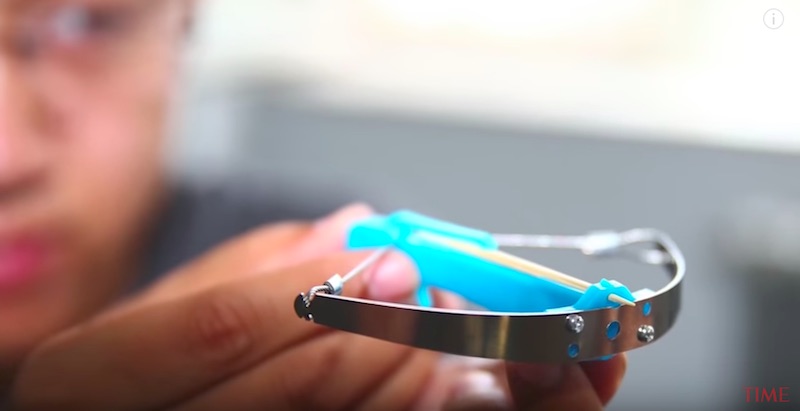
A dangerous new toy craze is sweeping Chinese school rooms: pocket-sized crossbows that can launch toothpicks, nails and needles at unsuspecting children.
But exactly what are these toothpick crossbows, how do they work and what are the potential harms they could cause?
Though tiny, these toys are at best a nuisance, and in the worst case, can cause serious injuries, child-safety experts said.
"These tiny crossbows can launch sharp projectiles that can cause bodily harm to others, especially injury to the eye. These are not appropriate to be marketed as toys for children and should be banned," Dr. Gary Smith, president of the Child Injury Prevention Alliance, told Live Science. [Best Educational Toys & Games for 7- to 10-Year-Olds]
What they are
A toothpick crossbow is exactly what it sounds like: a pint-size, plastic crossbow fitted with a metal, grooved track that directs a small projectile, such as a toothpick, needle or nail. Any parent looking at these devices will likely get a sinking feeling in his or her chest, instantly seeing both the appeal and the danger the toys pose. People can use the crossbows to launch toothpicks for a less painful sting, or they can launch nails or needles to do even more damage.
The products work like traditional crossbows, only smaller. As a result, unlike traditional crossbows, the new toys can fit in one hand and be fired single-handed; they can launch projectiles as far as 30 to 40 feet (9.1 to 12.2 meters), according to toothpickcrossbows.com. Videos online show that these projectiles not only have a large range, but can also pierce the flesh of an apple. Tests conducted by the Shanghai Daily newspaper showed the crossbows easily piercing cardboard and popping balloons.
And because these toys can be hidden, kids can take the crossbows into locations, such as schools, where traditional projectile-firing toys (other than a slingshot) could not be concealed for long.
Get the world’s most fascinating discoveries delivered straight to your inbox.
The products have yet to take off in the United States, but have become a huge fad in China, where kiosks near elementary schools sell the toys for as little as $1, CNN reported.
Safety concerns
The Chinese government has cracked down on these popular toys, with police now raiding toy shops to confiscate the devices, CNN reported. A total of 3,973 officers seized 528 crossbows in the Zhejiang province, according to CNN.
"Business owners shouldn't sell toys that are physically or mentally harmful to minors," said the Administration for Industry and Commerce of Chengdu, in the provincial capital of Sichuan. "Once found, the products will be pulled from the shelves, and the businesses will be punished."
But why exactly are these toys so dangerous?
"It's a projectile. Any type of projectile can cause a problem," said Dr. Mike Gittelman, a professor of pediatrics at the Division of Emergency Medicine at Cincinnati Children's Hospital and the co-director of the hospital's Comprehensive Children's Injury Center.
The key concern with this toy is the potential for an eye injury, Gittelman said. In fact, a 10-year-old boy in Xinjiang, China, likely sustained permanent damage after a projectile launched by a mini-crossbow hit him in the eye. [9 Weird Ways Kids Can Get Hurt]
The same principle applies to other types of projectile toys, such as BB guns, pellet guns and even Nerf guns. One of the real dangers is that the toy's potential for harm may not be immediately apparent, Gittelman said.
"A lot of the times, a kid will get hit by one of those and it won't hurt a lot but it might kind of sting, so they think it's kind of funny without knowing what the risk is," Gittelman said.
While the eye is the primary site of potential injury, if these objects were launched at the ears, it could also cause significant ear trauma, he said. If someone were to launch nails from these toys, the projectiles could pierce bones and cause a dangerous bone infection called osteomyelitis. Gittelman has even seen a BB gun go through someone's skin and pierce the heart, he added.
Potential bans?
Though China is cracking down on these toys' distribution, the pint-sized crossbows are still legal in the United States. The U.S. Consumer Product Safety Commission (CPS) has not issued a recall for any of the products, according to a spokesman for the commission. However, none of the listings for such products remain active on Amazon, which suggests the retailing giant voluntarily closed the listings.
Other fad toys have caused headaches and irritation for parents, but unlike more benign objects, such as fidget spinners, the toothpick crossbows come with significant risk for actual harm, Gittelman said.
Gittelman, for his part, has already contacted the CPSC to recommend that the commission keep an eye on the dangerous toys, he said.
"When you can cause catastrophic injury to a child, you have to weigh the risk versus the benefit," Gittelman said. "It looks like a dangerous item to be marketing."
While there are only limited reports of injury so far, the basic principles of projectiles have been used for millennia and the effects of similar projectile toys are well understood, he said.
"You could play devil's advocate and say these things haven't been tested enough," Gittelman told Live Science. "We know enough of other types of [projectiles] that these are worrisome enough."
Originally published on Live Science.

Tia is the editor-in-chief (premium) and was formerly managing editor and senior writer for Live Science. Her work has appeared in Scientific American, Wired.com, Science News and other outlets. She holds a master's degree in bioengineering from the University of Washington, a graduate certificate in science writing from UC Santa Cruz and a bachelor's degree in mechanical engineering from the University of Texas at Austin. Tia was part of a team at the Milwaukee Journal Sentinel that published the Empty Cradles series on preterm births, which won multiple awards, including the 2012 Casey Medal for Meritorious Journalism.


